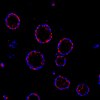Hepatitis B virus alters the antioxidant system in transgenic mice and sensitizes hepatocytes to Fas signaling.
Wang, Q; Na, B; Ou, JH; Pulliam, L; Yen, TS
PloS one
7
e36818
2011
Zobrazit abstrakt
Hepatitis B virus (HBV) is a major etiological factor of hepatocellular carcinoma (HCC). However, the precise pathogenetic mechanisms linking HBV infection and HCC remain uncertain. It has been reported that decreased antioxidant enzyme activities are associated with severe liver injury and hepatocarcinogenesis in mouse models. It is unclear if HBV can interfere with the activities of antioxidant enzymes. We established a HBV transgenic mouse line, which spontaneously developed HCC at 2 years of age. We studied the activities of the antioxidant enzymes in the liver of the HBV transgenic mice. Our results showed that the antioxidant enzymes glutathione peroxidase and superoxide dismutase 2 were down-regulated in HBV transgenic mice and correlated with JNK activation. HBV enhanced the Fas-mediated activation of caspase 6, caspase 8 and JNK without enhancing the activation of caspase 3 and hepatocellular apoptosis. As a proper redox balance is important for maintaining cellular homeostasis, these effects of HBV on the host antioxidant system and Fas-signaling may play an important role in HBV-induced hepatocarcinogenesis. | Western Blotting | 22606292
 |
Nerve terminal degeneration is independent of muscle fiber genotype in SOD1 mice.
Carrasco, DI; Bichler, EK; Seburn, KL; Pinter, MJ
PloS one
5
e9802
2009
Zobrazit abstrakt
Motor neuron degeneration in SOD1(G93A) transgenic mice begins at the nerve terminal. Here we examine whether this degeneration depends on expression of mutant SOD1 in muscle fibers.Hindlimb muscles were transplanted between wild-type and SOD1(G93A) transgenic mice and the innervation status of neuromuscular junctions (NMJs) was examined after 2 months. The results showed that muscles from SOD1(G93A) mice did not induce motor terminal degeneration in wildtype mice and that muscles from wildtype mice did not prevent degeneration in SOD1(G93A) transgenic mice. Control studies demonstrated that muscles transplanted from SOD1(G93A) mice continued to express mutant SOD1 protein. Experiments on wildtype mice established that the host supplied terminal Schwann cells (TSCs) at the NMJs of transplanted muscles.These results indicate that expression of the mutant protein in muscle is not needed to cause motor terminal degeneration in SOD1(G93A) transgenic mice and that a combination of motor terminals, motor axons and Schwann cells, all of which express mutant protein may be sufficient. | | 20339550
 |
Lentiviral-mediated silencing of SOD1 through RNA interference retards disease onset and progression in a mouse model of ALS.
Raoul, C; Abbas-Terki, T; Bensadoun, JC; Guillot, S; Haase, G; Szulc, J; Henderson, CE; Aebischer, P
Nature medicine
11
423-8
2004
Zobrazit abstrakt
Mutations in Cu/Zn superoxide dismutase (encoded by SOD1), one of the causes of familial amyotrophic lateral sclerosis (ALS), lead to progressive death of motoneurons through a gain-of-function mechanism. RNA interference (RNAi) mediated by viral vectors allows for long-term reduction in gene expression and represents an attractive therapeutic approach for genetic diseases characterized by acquired toxic properties. We report that in SOD1(G93A) transgenic mice, a model for familial ALS, intraspinal injection of a lentiviral vector that produces RNAi-mediated silencing of SOD1 substantially retards both the onset and the progression rate of the disease. | | 15768028
 |
Development and characterization of human and mouse specific antibodies to CuZn-superoxide dismutase (SOD1).
Bartlett, S E, et al.
J. Neurosci. Methods, 98: 63-7 (2000)
1999
Zobrazit abstrakt
Mutations in the copper/zinc superoxide dismutase (SOD1) gene are associated with 15-20% of the familial forms of motor neuron disease. Mice where a transgene has been incorporated that encodes for the human SOD1 mutation develop a form of motor neurone disease that closely resembles human forms of this disease. We have produced and characterized species-specific antibodies to epitopes in the SOD1 protein, amino acids 25-37, a region that distinguishes between the human and the mouse species of SOD1. The antisera generated were unable to immunoprecipitate the mouse or the human forms of SOD1 from tissue extracts unless the homodimeric complex of SOD1 was denatured. As SOD1 exists as a homodimeric complex in the cytoplasm of cells, this suggests that amino acids in position, 25-37 are close to the dimeric interface of SOD1. | | 10837872
 |
















